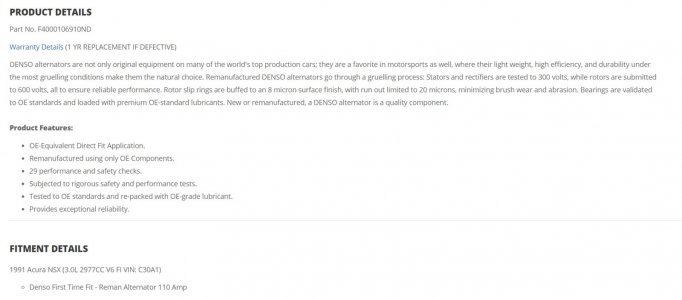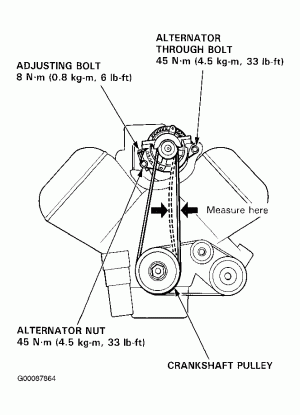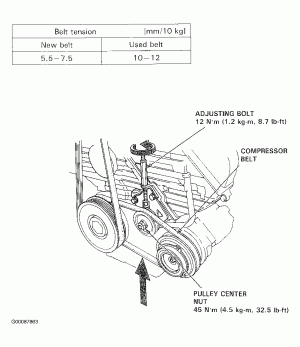Is there a recommended brand of replacement alternator? All I see these days are remanufactured alternators from places like Advanced Auto, Autozone, NAPA, OReilly. Advanced and NAPA have Denso, which I believe is the OE manufacturer, but I'm not sure if OEM really matters when it's remanufactured.
-
Protip: Profile posts are public! Use Conversations to message other members privately. Everyone can see the content of a profile post.
You are using an out of date browser. It may not display this or other websites correctly.
You should upgrade or use an alternative browser.
You should upgrade or use an alternative browser.
Denso vs Duralast vs. Bosch vs. NAPA alternator
- Thread starter qingcong
- Start date
Denso is OEM. NAPA is good. Stay away from all those others. DO NOT turn in your core, keep it.
You can replace the internals of the alternator with OEM parts. I highly recommend this!
What is wrong with it?
You can replace the internals of the alternator with OEM parts. I highly recommend this!
What is wrong with it?
Last edited:
Denso is OEM. NAPA is good. Stay away from all those others. DO NOT turn in your core, keept it.
You can replace the internals of the alternator with OEM parts. I highly recommend this!
What is wrong with it?
It's starting to whine and the voltage meter is more at 13V. I rode in a buddy's NSX and his was at 14V.
What internal parts would be replaced with OEM parts?
Parts available from Honda - an expensive proposition if you don't know what you are doing.
https://www.acuraoemparts.com/v-2000-acura-nsx-coupe--nsx-t--6-speed-manual/engine--alternator
The NSX alternator appears to be an orphan (the NSX was the only vehicle using it). So, an exact fit rebuild is likely a Denso. Your call as to whether Denso or Bosch is a better rebuilder. Be cautious with some vendors as you may get a new 'universal fit' alternator which may or may not be an 'easy fit'.
https://www.acuraoemparts.com/v-2000-acura-nsx-coupe--nsx-t--6-speed-manual/engine--alternator
The NSX alternator appears to be an orphan (the NSX was the only vehicle using it). So, an exact fit rebuild is likely a Denso. Your call as to whether Denso or Bosch is a better rebuilder. Be cautious with some vendors as you may get a new 'universal fit' alternator which may or may not be an 'easy fit'.
do what Drew says , Denso , its most likely a brush or bearing problem which are easy to replace , just follow the manual
First clean all your connections. At the alternator and both ends of the big cables at the battery.
If one can remove and replace the alternator yourself, then one can rebuild it themselves.
Usually, the voltage regulator dies. Might as well replace the brushes. Regulators are on eBay. And with Denso: if it fits, it ships...just get the one with the correct connector.
If a bearing is out, you should be able to easily replace that as well. Knock it out and then tap it in, along the perimeter of the bearing, using a punch or dowel of wood.
Plenty of youtube videos on diagnosing and repairing your alternator. The good news is that Denso is used in just about every car on the planet.
The problem is that cut rate rebuilders use crap bearings and knock off electronics. They don't last, will strand you and will cause mechanical damage when they fail as the drive belt rips around your engine compartment like a banshee. If you screw it up, then trade your core into for a Denso.
If one can remove and replace the alternator yourself, then one can rebuild it themselves.
Usually, the voltage regulator dies. Might as well replace the brushes. Regulators are on eBay. And with Denso: if it fits, it ships...just get the one with the correct connector.
If a bearing is out, you should be able to easily replace that as well. Knock it out and then tap it in, along the perimeter of the bearing, using a punch or dowel of wood.
Plenty of youtube videos on diagnosing and repairing your alternator. The good news is that Denso is used in just about every car on the planet.
The problem is that cut rate rebuilders use crap bearings and knock off electronics. They don't last, will strand you and will cause mechanical damage when they fail as the drive belt rips around your engine compartment like a banshee. If you screw it up, then trade your core into for a Denso.
Last edited:
First clean all your connections. At the alternator and both ends of the big cables at the battery.
If one can remove and replace the alternator yourself, then one can rebuild it themselves.
Usually, the voltage regulator dies. Might as well replace the brushes. Regulators are on eBay. And with Denso: if it fits, it ships...just get the one with the correct connector.
If a bearing is out, you should be able to easily replace that as well. Knock it out and then tap it in, along the perimeter of the bearing, using a punch or dowel of wood.
Plenty of youtube videos on diagnosing and repairing your alternator. The good news is that Denso is used in just about every car on the planet.
The problem is that cut rate rebuilders use crap bearings and knock off electronics. They don't last, will strand you and will cause mechanical damage when they fail as the drive belt rips around your engine compartment like a banshee. If you screw it up, then trade your core into for a Denso.
Thanks for the into. Why do you recommend repairing the alternator myself over installing a remanufactured alternator?
Last edited:
>The problem is that cut rate rebuilders use crap bearings and knock off electronics. They don't last, will strand you and will cause mechanical damage when they fail as the drive belt rips around your engine compartment like a banshee.
Rebuilds tend to be highly inferior to your original installed part.
Rebuilds tend to be highly inferior to your original installed part.
>The problem is that cut rate rebuilders use crap bearings and knock off electronics. They don't last, will strand you and will cause mechanical damage when they fail as the drive belt rips around your engine compartment like a banshee.
Rebuilds tend to be highly inferior to your original installed part.
What about a Denso remanufactured alternator? The website claims OEM this and that. I'm not questioning your knowledge, I'm just trying to find the easiest way out with as little work as needed... :smile:

Please DO question my knowledge and abilities. If I cannot hold my ground, then I am to be dismissed. I wish to have the best information and skills at all times, especially if I hold the incorrect view; and the only way to know is to be challenged. I defer to the best and have no issues with that.
The Denso sounds great: get it.
However, keep your existing part, put it in the box stating "NSX, bearing whine, ~13V output".
The reason is that (in general) the factory parts on your car are the best-manufactured parts. Even Dealer spares may not have as high quality. It is rare now to have the top Japanese, US or German bearings...everything is being outsourced that may have lessor quality and materials. Some of it might even be counterfeit, it is hard to tell when supply lines go around the world several times to make a single component.
Good Luck
The Denso sounds great: get it.
However, keep your existing part, put it in the box stating "NSX, bearing whine, ~13V output".
The reason is that (in general) the factory parts on your car are the best-manufactured parts. Even Dealer spares may not have as high quality. It is rare now to have the top Japanese, US or German bearings...everything is being outsourced that may have lessor quality and materials. Some of it might even be counterfeit, it is hard to tell when supply lines go around the world several times to make a single component.
Good Luck
Please DO question my knowledge and abilities. If I cannot hold my ground, then I am to be dismissed. I wish to have the best information and skills at all times, especially if I hold the incorrect view; and the only way to know is to be challenged. I defer to the best and have no issues with that.
The Denso sounds great: get it.
However, keep your existing part, put it in the box stating "NSX, bearing whine, ~13V output".
The reason is that (in general) the factory parts on your car are the best-manufactured parts. Even Dealer spares may not have as high quality. It is rare now to have the top Japanese, US or German bearings...everything is being outsourced that may have lessor quality and materials. Some of it might even be counterfeit, it is hard to tell when supply lines go around the world several times to make a single component.
Good Luck
Okay, that makes sense to me. I am an EE, but once things get into the realm of belts, pulleys, hydraulics, bearings, that's pushing my comfort zone.
Alt
The alt. in my 2000 started to whine. The whine was caused by a bad diode. I removed it and took it to a local starter and alt. shop. They replaced the bearings and brushes. They also replaced the diodes and glass beaded the case. One day service and it cost $80 or $90. Check around your neighborhood to see if a local shop will do the rebuild. Jerry
The alt. in my 2000 started to whine. The whine was caused by a bad diode. I removed it and took it to a local starter and alt. shop. They replaced the bearings and brushes. They also replaced the diodes and glass beaded the case. One day service and it cost $80 or $90. Check around your neighborhood to see if a local shop will do the rebuild. Jerry
The alt. in my 2000 started to whine. The whine was caused by a bad diode. I removed it and took it to a local starter and alt. shop. They replaced the bearings and brushes. They also replaced the diodes and glass beaded the case. One day service and it cost $80 or $90. Check around your neighborhood to see if a local shop will do the rebuild. Jerry
Mine whines above 3k RPM. Was yours a constant whine?
The reason is that (in general) the factory parts on your car are the best-manufactured parts. Even Dealer spares may not have as high quality. It is rare now to have the top Japanese, US or German bearings...everything is being outsourced that may have lessor quality and materials. Some of it might even be counterfeit, it is hard to tell when supply lines go around the world several times to make a single component.
Good Luck
I've been thinking about this some and the thing I wonder is, even if I do rebuild the alternator, it seems to me the replacement parts for it would also be less than OEM quality. So I see your point about keeping the original alternator, it just seems to me that no matter what, it's never going to be as good as OEM.
> it just seems to me that no matter what, it's never going to be as good as OEM.
Possibly. However, YOU as the re/builder get to choose the BOM that goes into your device. Denso still makes all the parts and there are still high-quality bearings available; probably NOS if you require it.
A scope should be able clear up post haste whatever is wrong with your alternator. I'm surprised that you as an EE have not hit it with an o-scope already.
Possibly. However, YOU as the re/builder get to choose the BOM that goes into your device. Denso still makes all the parts and there are still high-quality bearings available; probably NOS if you require it.
A scope should be able clear up post haste whatever is wrong with your alternator. I'm surprised that you as an EE have not hit it with an o-scope already.
Whine
Yes, the whine from the alt. was constant. The guy that rebuilt it said that that different diodes kick in at different speeds. Mine whined at idle to about 2000 rpm. The shop hooked it up to a giant DC motor and you could clearly hear it. Jerry
Yes, the whine from the alt. was constant. The guy that rebuilt it said that that different diodes kick in at different speeds. Mine whined at idle to about 2000 rpm. The shop hooked it up to a giant DC motor and you could clearly hear it. Jerry
> it just seems to me that no matter what, it's never going to be as good as OEM.
Possibly. However, YOU as the re/builder get to choose the BOM that goes into your device. Denso still makes all the parts and there are still high-quality bearings available; probably NOS if you require it.
A scope should be able clear up post haste whatever is wrong with your alternator. I'm surprised that you as an EE have not hit it with an o-scope already.
Oscopes, now we're talking my language. What should I measure with the oscope?
Oscopes, now we're talking my language. What should I measure with the oscope?
I'm just a CS puke. I realize analog EE is ancient, but I'd imagine you would look for anomalies and noise when compared to a flat 12V voltage stream. Just have to match your time division with the RPM.
A quick YT search reveals: https://www.youtube.com/watch?v=7wfEmqL6Ijs
AliExpress has some inexpensive (US$5,$10,$20,$100-$250) LCD o-scopes, some with multi-trace too, that would probably work great for automotive type diagnosis.
Last edited:
There is no separate tensioner on the alternator. Tension is adjusted by actually moving the alternator. On the top diagram above:
- loosen the through bolt just a little (this makes it easier for the alternator to pivot on the through bolt as you are doing the adjustment).
- loosen the alternator nut (this should allow you to turn the adjusting bolt)
- turn the adjusting bolt to increase or decrease tension on the belt.
- once desired tension is obtained, tighten alternator nut and then through bolt.
- loosen the through bolt just a little (this makes it easier for the alternator to pivot on the through bolt as you are doing the adjustment).
- loosen the alternator nut (this should allow you to turn the adjusting bolt)
- turn the adjusting bolt to increase or decrease tension on the belt.
- once desired tension is obtained, tighten alternator nut and then through bolt.
There is no separate tensioner on the alternator. Tension is adjusted by actually moving the alternator. On the top diagram above:
- loosen the through bolt just a little (this makes it easier for the alternator to pivot on the through bolt as you are doing the adjustment).
- loosen the alternator nut (this should allow you to turn the adjusting bolt)
- turn the adjusting bolt to increase or decrease tension on the belt.
- once desired tension is obtained, tighten alternator nut and then through bolt.
Wow, I actually understand this. Thanks!
There is no separate tensioner on the alternator. Tension is adjusted by actually moving the alternator. On the top diagram above:
- loosen the through bolt just a little (this makes it easier for the alternator to pivot on the through bolt as you are doing the adjustment).
- loosen the alternator nut (this should allow you to turn the adjusting bolt)
- turn the adjusting bolt to increase or decrease tension on the belt.
- once desired tension is obtained, tighten alternator nut and then through bolt.
Follow-up question:
Aside from the various electrical cables, covers, are these bolts the main things I need to remove to take out & replace the alternator?
Last edited:
I just removed mine recently and something that you might want to know is that the electrical connector just pulls out. It was clear to me at the time whether there was some kind of thing which held it in place .. or whether it needed to be rotated before pulling it out .. but just pulling it straight back was the right answer.Wow, I actually understand this. Thanks!
I took mine to a starter/alt rebuild shop and they replaced the bearings and brushes and tested the output to make sure it was up to spec .. cost was about $100 Cdn if I recall. The reason I took it in was that the bearings were starting to squeal when I started it in the winter. After 200k miles and 18 Canadian winters without a rebuild, I thought it was time.
Yes, that's it.Follow-up question:
Aside from the various electrical cables, covers, are these bolts the main things I need to remove to take out & replace the alternator?
Alt.
Don't forget to disconnect your battery before you remove the alt. Jerry
Don't forget to disconnect your battery before you remove the alt. Jerry
Similar threads
- Replies
- 19
- Views
- 5K
- Sticky
- Replies
- 20
- Views
- 8K
- Sticky
- Replies
- 43
- Views
- 21K
- Replies
- 2
- Views
- 5K
- Replies
- 11
- Views
- 2K








